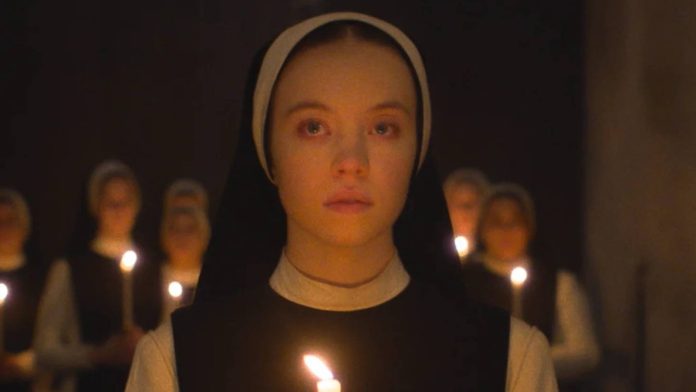**Unveiling the Shocking Ending of Sydney Sweeney’s Immaculate: A Gripping Tale of Control and Resistance**
Sydney Sweeney takes the horror genre by storm in Michael Mohan’s 2024 film, **”Immaculate.”** In a radical shift from her previous roles, Sweeney swaps the familiar high school hallways of *Euphoria* for the haunting setting of an Italian convent. However, it’s far from the tranquil refuge one might expect. Instead, she portrays Sister Cecilia, a young woman unknowingly trapped in an insidious world, discovering that her journey to save dying nuns leads to a fate that could very well be worse than death itself—**an unplanned pregnancy** rooted in what seems to be an immaculate conception.
**The Dark Reality Behind Sister Cecilia’s Struggle in Immaculate**
In this chilling narrative, Cecilia becomes a pawn, praised yet ultimately imprisoned within the convent’s walls. As she uncovers the devastating lengths to which this **unholy group** will go to ensure the safety of her child, viewers are thrust into an unflinching exploration of autonomy, trauma, and survival. The film’s climax does not shy away from horror; it compels audiences to confront uncomfortable truths about the bodies and choices of women. With blood, sweat, and a stone that acts as a weapon for her vengeance, *Immaculate* might just set the stage for potential sequels that delve deeper into Cecilia’s story.
**Immaculate: A Commentary on Women’s Autonomy**
Reflecting on Sister Cecilia’s harrowing journey, *Immaculate* resonates with the ethos of modern feminism, juxtaposed against the backdrop of religious doctrine. Unlike other films about miraculous pregnancies, this film uniquely addresses the chilling subject of women’s autonomy. The characters of Sister Gwen and Sister Isabelle highlight diverse experiences of oppression within the convent. Gwen, who bravely speaks out against the injustices she faces, suffers brutal consequences, while Isabelle’s failure to conform leads to her expulsion. Ultimately, Cecilia emerges as the embodiment of resilience—not just as a survivor but as the solitary protector fighting against a system designed to strip her of her freedom.
**Religion vs. Science: The Alarming Revelation in Immaculate**
As discussions simmer in the film’s tense atmosphere, a heartbreaking truth unfolds. When Cecilia fakes a miscarriage in a desperate bid to escape, she inadvertently unravels a dark connection between religion and science. The character of Father Sal Tedeschi, once a geneticist, now turned holy man, reveals that Cecilia’s predicament is rooted in scientific manipulation rather than divine intervention. Using DNA extracted from a crucifixion relic, he showcases the horrifying extent of human experimentation masked as divine will. This shocking twist not only serves as a clear critique of **institutionalized religion** but also signals the objectification of women portrayed as mere vessels.
**Cecilia’s Revenge: A Gripping Climax of Redemption**
In a realm where innocence is tarnished and morality is tested, Sweeney’s portrayal of Cecilia as a fierce warrior is truly compelling. In one electrifying scene, she channels tremendous fury into her escape, confronting the oppressive figures of authority—the Mother Superior and Father Tedeschi. This defiance is incredibly symbolic; with a Holy Relic laced with blood and vengeance in hand, Cecilia exacts revenge. The director, Michael Mohan, publicly praises Sweeney’s dedication, even sharing instances where she braved discomfort during filming, insisting on continuing despite the challenges. Her determination echoes the very essence of her character—a woman rising from the ashes of her challenges to reclaim her destiny.
**A Disturbing Ending: The Miracle and Its Aftermath**
Even as the narrative reaches its apex, the haunting truth of Cecilia’s struggles looms large. After making her escape, she confronts the ultimate horror—giving birth in a shocking single take that captures the raw, visceral agony of life and death competing for space. Disturbingly beautiful, this act is both a conclusion and a rebirth of a new narrative, straddling the line between liberation and despair. Mohan’s choice to leave the aftermath of the baby’s fate obscured catapults viewers into a silent void—the horror of the unseen lingering far longer than any image could evoke.
**Future of Immaculate: A Possible Sequel on the Horizon?**
As the film closes, an enticing question remains: just what does the future hold for Cecilia? The might-have-beens of *Immaculate* linger tantalizingly; the revelation of other nails buried in Father Tedeschi’s neck alludes to a larger universe. Could it imply that more sinister laboratories exist, waiting to be upended? The film’s success at the box office hints that audiences are eager for more. With *Immaculate* raking in $28 million against a $9 million budget, a sequel exploring Cecilia’s ongoing fight against religious oppression might not be so far-fetched after all.
Whether you’re a fan of horror, feminism, or simply remarkable storytelling, *Immaculate* challenges perspectives and promises to engage audiences in a dialogue long after the credits roll. Sydney Sweeney’s remarkable portrayal will undoubtedly leave a mark, compelling viewers to question not just what they saw, but what it truly means to be a woman in a world that often seeks to control them.

